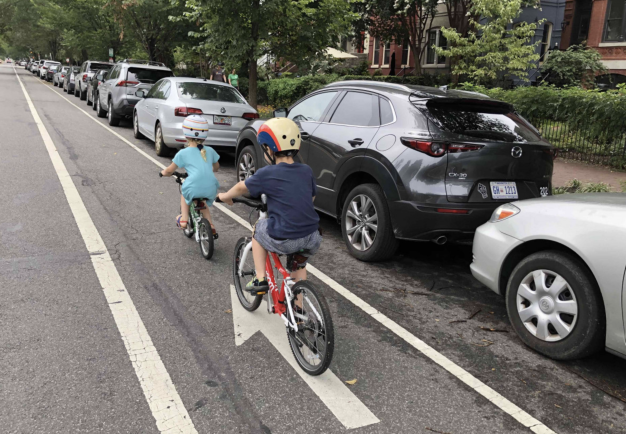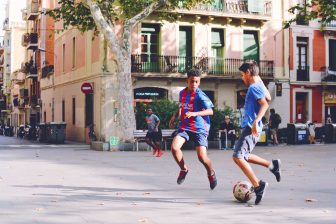As schools around the country prepared for Bike and Roll to School Day, Washington DC is looking to reverse decades of health inequities by making it safe for more kids to bike around their city.
In recent years, the District Department of Transportation has picked up the pace on building out DC’s public biking network, going from about 80 miles of bike lanes in early 2019 (when I started at GGWash) to more than 100 in 2022, plus about 60 miles of trails, writes Caitlin Rogger of Greater Greater Washington.
If children’s health and health equity matter to you, this is genuinely terrific news: the more kids who can safely bike where they’re going, the lower their current and lifetime risk from a host of noncommunicable conditions such as obesity and type II diabetes.
The Centers for Disease Control recommends one hour of physical activity every day for kids aged 6 – 17 years, but DC students get less than half of this minimum recommendation built into their school day, falling short of the District’s own legislated requirements. Worse yet, kids from lower-income households are less likely to participate in organized sports, so aren’t able to make up for limited movement during the school day with extra-curricular exercise.
World Health Organization guidelines back this up, recommending more physical activity and less sedentary time for young children: “Improving physical activity, reducing sedentary time and ensuring quality sleep in young children will improve their physical, mental health and wellbeing, and help prevent childhood obesity and associated diseases later in life,” comments Dr. Fiona Bull, program manager at the WHO. It’s not just young kids: experts on the same panel noted that more than 80% of adolescents worldwide aren’t sufficiently physically active to support healthy development. Noncommunicable diseases might seem like just an unavoidable part of life, but they contribute to some 5 million premature deaths a year.
Where and when are kids supposed to get this needed exercise? The opportunity to build more physical activity into kids’ days is sitting (literally) right in front of us: nearly every kid travels to school each week day. Because of land use and school siting decisions–which bear their own history of systematic racism–not all live close enough to walk or bike to school. But the kids who live in communities at higher risk of traffic violence are the same kids who are more likely to suffer the effects of limited physical activity. Safe active routes to school are essential for child health and for health equity.
Who’s afraid of kids getting sick?
Predictably, as the District allocates more space away from driving and parking lanes to bike lanes, there’s greater resistance to their implementation, if only because they are a visible change. See: North Carolina Ave NE, a one-block planned project which currently involves no net loss of parking. After nearly a year of public meetings on the matter and local ANC offers to assist several neighbors with disabled parking permits, some still decry an imaginary loss of –suspenseful pause– parking.
Anyone party to complaints about parking changes in service of infrastructure that promotes safety and active mobility, like curb bulb-outs, flex posts, bike lanes, raised crosswalks, and even ADA-mandated measures, might suppose that Maslow made a crucial error in leaving “certainty of home-adjacent parking” out of his hierarchy of needs.
Of course, he didn’t leave out a crucial piece, or, if he did, it wasn’t parking or driving fast. Health and safety come before convenience in almost any moral framework. Emerging from a pandemic when keeping the economy humming was balanced on a daily basis with health may have muddied the waters of what comes first in public values (people die in recessions too, an economist in my family is fond of reminding me). But it remains the case that children’s health is one of our most important charges as a society. Adults have always had that power and that duty, whether or not we choose to fulfill it.
That leaves us with an important conclusion: Building out a protected bike lane network is an essential element of children’s health in cities.
Failing grades for DC’s air quality last month lend a public-good argument to the urgent need to shift car trips to other modes. Air pollution is a significant factor for chronic illnesses like asthma and lung cancer. But the health benefits of shifting trips to active modes like walking and biking extend further still to prevention of obesity, type II diabetes, and cardiovascular disease, as well as improvements in mental health and overall well-being.
The retort that biking, or walking or rolling, isn’t available to everyone is simultaneously true and self-fulfilling. A cycling network that doesn’t protect users is only available to the fittest and bravest cyclists (among which I certainly don’t count myself; I ride with a chronic injury): a Darwinian dynamic. But the further we move toward a low-stress, genuinely protected system, the more of us, particularly the vulnerable individuals like children and indeed seniors, can take advantage of the benefits that cycling offers.
Active transportation and public health go hand-in-hand
Most of the illnesses that biking can help tackle, at least for kids, are issues in the District according to our Department of Health’s Health Equity Report, as well as other cities in the region. Most of us don’t have to look kids in the eye who have a preventable disease–one we could have helped them avoid if we were up for driving slightly less–on a daily basis and defend that choice. But if we did, if we were honest with ourselves about that tradeoff, the path is clear: kids deserve the opportunity to bike and walk to school safely, and we adults have the power to provide the conditions that make it possible.
Links between active transportation and kids’ health have at least got the attention of DC lawmakers, who have introduced a series of bills related to safer movement for pedestrians, cyclists and indeed drivers around schools. But the fights will only get more intense as our priorities shift to embrace the safety of kids and others, and so must the efforts to engage communities but also to lead us to cities that don’t fail kids on health and safety alike.
Something I’d like to see come out of this year’s local elections? Officials emerge with a lot more confidence that no-brainers around children’s health and safety sometimes require trade-offs that some, even many, adults find challenging or scary. I’d like them to make decisions about transportation as if they were going to look in the eyes of kids whose health has been worsened by adults’ trips by car, and defend their choice. That’s what leaders do.
This article is reproduced under a Creative Commons License.
Caitlin Rogger is deputy executive director at Greater Greater Washington, a volunteer-driven, non-profit organisation that brings people together online and offline to discuss, organise, and advocate for an inclusive, diverse, growing Washington, DC region where all people can choose to live in walkable urban communities.





